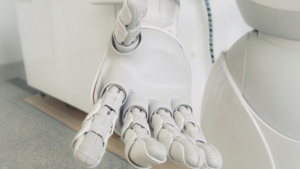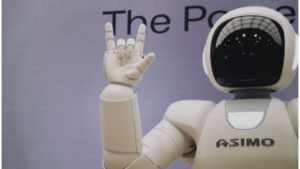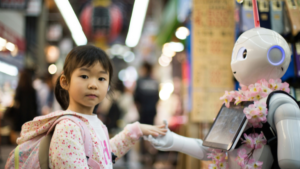
1.AI and Machine Learning:
Robotics is increasingly leveraging artificial intelligence (AI) and machine learning algorithms to improve decision-making capabilities, enabling robots to adapt to changing environments and learn from experience.
2.Collaborative Robots (Cobots):
Collaborative robots are designed to work alongside humans, enhancing productivity and safety in various industries such as manufacturing, healthcare, and logistics.
These robots are equipped with advanced sensors and safety features to operate safely in shared workspaces.
3.Autonomous Vehicles and Drones:
The development of autonomous vehicles and drones is revolutionizing transportation and logistics.
Self-driving cars, trucks, and drones have the potential to increase efficiency, reduce accidents, and optimize supply chains.
4.Industry 4.0 and Smart Factories:
Robotics plays a central role in the concept of Industry 4.0, where automation, data exchange, and IoT technologies are integrated into manufacturing processes.
Smart factories equipped with robotic systems enable flexible, efficient, and customizable production.
5.Service Robots:
Service robots are being deployed in various sectors, including hospitality, healthcare, retail, and agriculture, to perform tasks such as customer assistance, cleaning, delivery, and crop monitoring.
These robots enhance customer experiences, improve operational efficiency, and address labor shortages.
6.Medical Robotics:
Robotics is transforming healthcare with applications such as robot-assisted surgery, rehabilitation robotics, telemedicine robots, and assistive devices for the elderly and disabled.
These technologies enhance precision, reduce medical errors, and improve patient outcomes.
7.Environmental Robotics:
Robotics is increasingly being used for environmental monitoring, conservation, and disaster response.
Robots equipped with sensors and cameras can collect data in hazardous or hard-to-reach environments, helping researchers and authorities make informed decisions and respond effectively to emergencies.
8.Personal Robotics:
Personal robots designed for household chores, entertainment, and companionship are becoming more sophisticated and affordable.
These robots offer convenience and assistance to individuals and families. They are particularly beneficial in aging societies and busy urban environments.
9.Swarm Robotics:
Swarm robotics involves coordinating large numbers of simple robots to work together collaboratively, mimicking the behavior of social insects like ants or bees.
This approach can be applied to tasks such as exploration, search and rescue missions, and environmental monitoring, where a single robot may be limited in capability or efficiency.

10.Robotic Process Automation (RPA):
RPA involves automating repetitive tasks and workflows using software robots or “bots.”
These bots can perform tasks such as data entry, form processing, and report generation, freeing up human workers to focus on more creative and strategic activities.
11.3D Printing and Additive Manufacturing:
This integration enables faster prototyping, customization, and on-demand manufacturing.
12.Energy and Resource Efficiency:
Robotics can contribute to energy and resource efficiency by optimizing processes, reducing waste, and minimizing environmental impact.
For example, robots equipped with advanced sensors and algorithms can optimize energy usage in buildings, improve irrigation efficiency in agriculture, and reduce fuel consumption in transportation.
13.Education and Research:
Educational robots like LEGO Mindstorms and research platforms such as ROS (Robot Operating System) foster innovation and knowledge exchange in the robotics community.
14.Ethical and Social Implications:
As robotics technology advances, there are important ethical and social implications to consider, including job displacement, privacy concerns, and the potential for misuse or unintended consequences.

15.International Collaboration and Standards:
International collaboration and common standards are essential in robotics research to ensure interoperability, safety, and ethical guidelines globally.
Consequently, by fostering collaboration and standardization, the robotics community can address challenges more effectively and advance the field cohesively.
The International Federation of Robotics (IFR) facilitates cooperation and knowledge sharing in the robotics community.
Conclusion
These additional points highlight the diverse applications, challenges, and opportunities in the future of automation in robotics. Moreover, as technology continues to evolve, robotics will continue to play a transformative role in shaping the way we live, work, and interact with the world around us.
From swarm robotics to 3D printing integration, the potential for innovation is vast. However, alongside these opportunities, there are also ethical and social implications to consider. Thus, international collaboration and the establishment of common standards become crucial. Addressing these challenges collectively will ensure that robotics benefits humanity as a whole.

